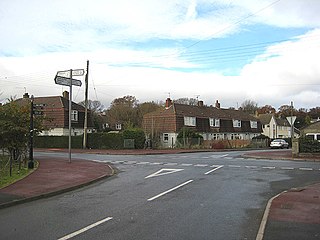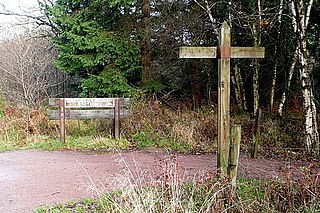
The Forest of Dean is a geographical, historical and cultural region in the western part of the county of Gloucestershire, England. It forms a roughly triangular plateau bounded by the River Wye to the west and northwest, Herefordshire to the north, the River Severn to the south, and the City of Gloucester to the east.

Parkend is a village, located at the foot of the Cannop Valley, in the Royal Forest of Dean, West Gloucestershire, England, and has a history dating back to the early 17th century. During the 19th century it was a busy industrial village with several coal mines, an ironworks, stoneworks, timber-yard and a tinplate works, but by the early 20th century most had succumbed to a loss of markets and the general industrial decline. In more recent times, the village has become a tourist destination.

Coleford is a market town in the west of the Forest of Dean, Gloucestershire, England, two miles (3 km) east of the Welsh border and close to the Wye Valley. It is the administrative centre of the Forest of Dean district. The combined population of the town's two electoral wards at the 2011 census was 8,359. The population of the town's parish was 9,273 in the 2021 Census. The parish includes the village of Baker's Hill.

The Dean Forest Railway is a 4+1⁄4-mile (6.8 km) long heritage railway that runs between Lydney and Parkend in the Forest of Dean, Gloucestershire.

Milkwall is a village in the Forest of Dean in Gloucestershire, England. It lies between the village of Sling to the south, and the town of Coleford to the north. Milkwall, strictly speaking, lies South of Station Rd in the parish of West Dean, whereas Tufthorn is North of Station Rd in the parish of Coleford.

Parkend railway station is located in the village of Parkend, in the Forest of Dean, Gloucestershire. It is currently the northern terminus of the Dean Forest (heritage) Railway.

The Severn and Wye Railway began as an early tramroad network established in the Forest of Dean to facilitate the carriage of minerals to watercourses for onward conveyance. It was based on Lydney, where a small harbour was constructed, and opened its line to Parkend in 1810. It was progressively extended northwards, and a second line, the Mineral Loop was opened to connect newly opened mineral workings.

Sling is a village in Gloucestershire, England. The village is located between Clearwell and Bream. It is just south of the village of Milkwall.

The Wye Valley Railway was a standard gauge railway that ran for nearly 15 miles (24 km) along the Lower Wye Valley between the towns of Chepstow and Monmouth, crossing several times between Wales and England. Opened on 1 November 1876, it was leased to, and worked by, the Great Western Railway (GWR), before being fully absorbed by the GWR in 1905.

Monmouth Troy was one of the two former railway stations at Monmouth. It was built in 1857 by the Coleford, Monmouth, Usk and Pontypool Railway and was used by several other branch lines as the local rail network expanded. The station closed in January 1964 following the closure of the last two lines to the station, the Wye Valley Railway and the Ross and Monmouth Railway.
The Coleford Railway was a railway company that constructed a short railway from near Monmouth to Coleford, close to the Forest of Dean. The company was sponsored by the Great Western Railway. It was built on part of the course of the Monmouth Railway, a horse-operated plateway, and it was intended that its primary business would be the conveyance of minerals and forest products from the Forest of Dean.
Tidenham Station was the station for the village of Tidenham on the former Wye Valley Railway in the Forest of Dean, Gloucestershire, England. It was opened in 1876 during the construction of the line and closed on 5 January 1959 following the closure of the line to passenger services. The next station on the line was Netherhope Halt.

The Coleford, Monmouth, Usk & Pontypool Railway (CMU&PR) was a standard gauge railway of 16 miles (26 km) which ran from Monmouth to Little Mill, near Pontypool in Monmouthshire, Wales. It was intended to convey the mineral products of the Forest of Dean to the ironworks of South Wales, by connecting to the Newport, Abergavenny and Hereford Railway at Little Mill Junction. The NAHR made the onward connection over its Taff Vale Extension line. The CMU&PR intended to acquire the Monmouth Railway, actually a horse-operated plateway, and convert it to locomotive operation.
Wyesham Halt was a request stop at Wyesham on the former Wye Valley Railway, it was also used by the Coleford Railway. It was opened on 12 January 1931 and closed in January 1959. The railway between Wyesham Halt and Monmouth Troy was originally built by the Coleford, Monmouth, Usk and Pontypool Railway in 1861.

Usk (GWR) railway station is a disused railway station in the town of Usk, Monmouthshire, Wales. The station is now barely recognisable with the remains of the platforms beneath undergrowth, but the trackbed, the adjacent Usk Tunnel and road and river bridges remain extant and can be walked.

Speech House Road railway station is a disused railway station opened by the former Severn and Wye Railway in 1875, it remained open for 88 years until the line, north of Parkend, closed to freight in 1963. Passenger trains on the Severn and Wye Railway, north of Lydney, were withdrawn from 1929.

Drybrook Road is a closed station on the Cinderford to Coleford direct railway line in the Forest of Dean in Gloucestershire, near the village of Drybrook. The former station was on the former Severn and Wye Railway system. It opened in 1875 and closed in 1929.
Coleford (Severn and Wye) railway station is one of two former stations that served the town of Coleford, Gloucestershire, England. The station was the northern terminus of the former Severn and Wye Railway.
Newland railway station, also known as Cherry Orchard railway station, served the village of Newland, Gloucestershire, England, from 1883 to 1917 on the Coleford Railway.
Coleford railway station served the town of Coleford, Gloucestershire, England, from 1883 to 1917 on the Coleford Railway.












